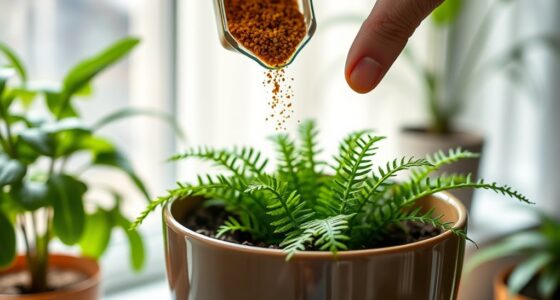To keep your peace lily blooming, make certain you water it properly—allow the top inch of soil to dry out before watering again, and water thoroughly to avoid root rot. Watch for signs of pests like spider mites or mealybugs, and keep leaves clean to prevent infestations. Adjust watering and pest control strategies as needed, and pay attention to your plant’s health cues. Continue exploring care tips to help your peace lily flourish and produce beautiful white flowers.
Key Takeaways
- Maintain consistent, thorough watering to prevent root rot and ensure healthy blooming conditions.
- Regularly inspect for pests like spider mites and mealybugs; treat promptly to protect flowers.
- Keep leaves clean by wiping with a damp cloth to reduce dust and pest hiding spots.
- Avoid overwatering or underwatering; check soil moisture and adjust watering accordingly.
- Provide adequate light and proper fertilization to encourage flowering and overall plant health.

Have you ever noticed your Peace Lily struggling to stay healthy? It’s a common concern among plant enthusiasts, and often, the root causes are tied to watering issues or pest management problems. Recognizing these early signs can help you intervene before your plant’s health declines further. Peace Lilies thrive when they receive just the right amount of water—neither too much nor too little. Overwatering can lead to root rot, causing wilting, yellowing leaves, and even plant death. Conversely, underwatering results in droopy leaves and brown tips. To avoid these issues, always check the top inch of soil; if it feels dry, it’s time to water. When you do water, do so thoroughly, ensuring excess water drains out, preventing water from pooling at the bottom. Maintaining a consistent watering schedule helps your Peace Lily develop strong roots and vibrant foliage.
Pest management is another vital aspect of keeping your Peace Lily healthy and blooming. Common pests like spider mites, mealybugs, and scale insects can quickly take hold if you’re not vigilant. These pests often hide on the undersides of leaves or within leaf axils, making early detection key. When you notice tiny webs, sticky residues, or discolored patches, it’s time to act. Use a gentle stream of water to dislodge pests or apply insecticidal soap or neem oil, which are safe options for indoor plants. Regularly inspecting your Peace Lily helps catch infestations early, preventing severe damage. It’s also a good idea to keep your plant clean by wiping down leaves with a damp cloth, removing dust and potential pests.
Addressing watering issues and pest management early on can greatly enhance your Peace Lily’s chances of blooming beautifully. Proper watering not only keeps the plant hydrated but also helps prevent fungal issues that can weaken it. Meanwhile, staying vigilant for pests ensures your plant isn’t compromised by unwanted invaders. If you notice symptoms like browning leaf edges or stunted growth, consider whether watering habits need adjustment or if pests are the culprits. Combining consistent watering practices with proactive pest management creates a healthy environment for your Peace Lily to thrive. With attentive care, your plant will reward you with lush, shiny leaves and the signature white blooms that make it such a popular houseplant.
Frequently Asked Questions
How Often Should I Water My Peace Lily?
You should water your peace lily about once a week, ensuring the soil moisture stays consistently moist but not soggy. Check the top inch of soil regularly; if it feels dry, it’s time to water. Adjust your watering schedule based on the environment’s humidity and temperature, as these factors influence soil moisture retention. Proper watering helps promote healthy growth and blooming.
Why Are My Peace Lily Leaves Turning Yellow?
Think of your peace lily as a well-tended garden, where yellowing leaves signal trouble. When leaves turn yellow, it often means your plant’s leaf yellowing is due to stress, possibly from overwatering or poor root health. Check the roots to verify they’re not rotting, and adjust your watering habits. Keeping roots healthy and providing proper care will restore vibrant green leaves and keep your peace lily thriving.
How Do I Encourage My Peace Lily to Bloom Again?
To encourage your peace lily to bloom again, make sure it gets the right fertilizer needs—use a balanced, water-soluble fertilizer every 6 weeks during active growth. Pruning techniques help by removing dead or yellow leaves, which directs energy toward new blooms. Keep the plant in bright, indirect light and maintain consistent watering. With proper care, your peace lily will reward you with beautiful blooms once more.
What Is Causing Brown Tips on My Peace Lily?
Brown tips on your peace lily’s leaf edges often result from dry air, inconsistent watering, or over-fertilizing. You should regularly check humidity levels, make sure you’re watering when the topsoil feels dry, and avoid overfeeding. Trim off the brown tips with clean scissors, and increase humidity by misting or using a humidifier. By maintaining proper watering, humidity, and care, you’ll help prevent brown tips and keep your plant healthy and vibrant.
Can Peace Lilies Tolerate Direct Sunlight?
Yes, peace lilies can tolerate some direct sunlight, but too much can cause leaf color to fade and leaf scorch. You should provide them with bright, indirect sunlight for ideal growth. If they’re in direct sunlight, their leaves may develop brown tips or spots. Keep an eye on sunlight exposure, and if needed, move your peace lily to a shadier spot to prevent damage and maintain healthy, vibrant foliage.
Conclusion
Now that you know how to identify and fix common peace lily problems, keeping your spathiphyllum healthy and blooming becomes easier. With proper care and attention, you’ll enjoy its lush greenery and elegant blooms for years to come. Are you ready to give your peace lily the love it needs to thrive? Remember, a little effort goes a long way in ensuring your plant remains vibrant and beautiful. Happy gardening!










